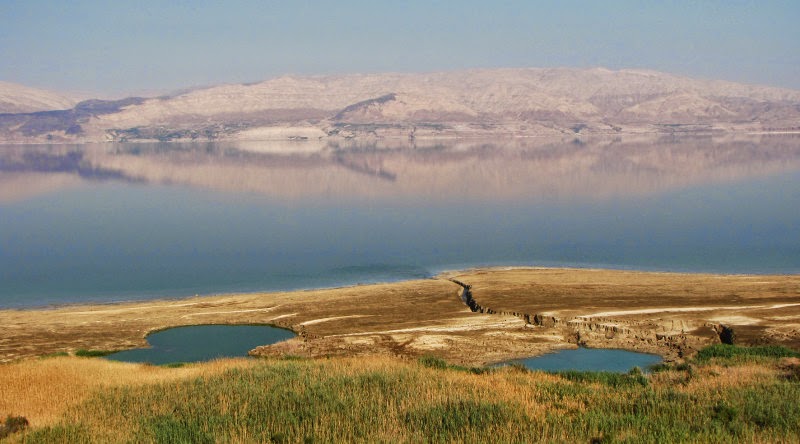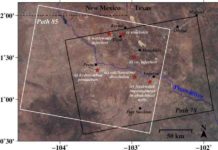
The drinking water resources on the eastern, Jordanian side of the Dead Sea could decline severe as a result of climate change than those on the western, Israeli and Palestinian side. This is the conclusion reached by an international team of researchers that calculated the water flows around the Dead Sea. The natural replenishment rate of groundwater will reduce dramatically in the future if precipitation lowers as predicted, say the scientists, writing in the journal Science of the Total Environment. Even now, the available groundwater resources in the region are not sufficient to meet the growing water requirements of the population and agriculture. If the situation worsens, it could therefore have serious social, economic and ecological consequences for the region.
Important data for water providers
A reliable inventory of existing water resources around the Dead Sea, on the border between Israel, Palestine and Jordan, forms the basis for sustainable water management. The lowest lake on earth is not only one of the biggest tourist attractions in the Middle East; more than four million people rely on the groundwater resources in its catchment basin. For a long time, the complex hydrology of this region presented major unknown factors in the local water balance equation. To some extent it still does. Thanks to improved computer simulations, the researchers were able to work out — on an international scale for the first time — how much water actually infiltrates from rainfall and replenishes the groundwater reservoir: around 281 million cubic metres per year. This means that we now also know what the maximum withdrawal limit should be if this resource is to be managed sustainably.
A complicated puzzle with many pieces
Since the 1960s, the majority of the Dead Sea’s tributaries have been dammed to capture the precious water before it disappears into the salt lake. However, this apparent salvaging of water is causing the water level of the Dead Sea to fall by around a metre per year and, with it, the surrounding groundwater levels. Fresh water springs thousands of years old are ebbing away. This much was already known. What was not clear was exactly what impact the retreating water levels have on the quantities of usable groundwater. Over the past five years, the team of researchers from Germany, Israel, Jordan and Palestine working on the SUMAR research project therefore used a combination of comprehensive on-site measurements, remote sensing and computer modelling systems to be able to provide a fairly complete answer to this question.
Tracing the course of the water
The springs in and around the Dead Sea were identified using infra-red sensors on aircraft and satellites, as well as chemical and isotopic methods. “By analysing rare earth elements in particular we were able to trace the origin of the water and the routes it takes underground,” reports Dr Christian Siebert of the Centre for Environmental Research (UFZ). “Not only were we able to locate 37 areas where groundwater flows into the Dead Sea, we now also know the history of each source. This was important for finding out how much fresh water flows into the Dead Sea underground and is therefore no longer available to use as drinking water. The last passage in particular, before the water from the mountains reaches the lake, took us a long time,” says the hydrogeologist. “Here, salt water rising from below mixes with the fresh water, and salt minerals are dissolved in it. But, together with colleagues from the Max Planck Institute in Bremen, we also managed to identify the biogeochemical processes that make permanent changes to the groundwater.”
Computer models calculate the total water balance
In the end, all the available data were fed into computer models that revealed, more accurately than ever before, the situation in the drainage basin in the immediate vicinity of the Dead Sea — an area measuring roughly 7000 square kilometres. The biggest challenges were the heterogeneous distribution of urban areas and the associated gaps in the data. Whereas the number of measuring stations in and around built-up areas like Jerusalem and Amman is very high, there are broad stretches of land that are very sparsely populated and therefore have only few wells and almost no geological or meteorological data. Yet rain is particularly important in this context. The region is characterised by short, heavy downpours that often fall over a very small area. For this reason, the project team set up its own measurement stations so as to be able to measure the flash floods that result from these downpours. A comprehensive flow-measuring station was also set up on the River Jordan near one of the baptismal sites that attract thousands of Christian pilgrims every year.
Bleak forecasts
Using the models, the scientists were able, for the first time, to make predictions about possible future changes in the groundwater resources that are so vital for this region: the western (Israeli-Palestinian) side of the lake receives almost twice as much rainfall as the eastern (Jordanian) side. As a result, groundwater replenishment rates are currently around 50 per cent higher on the western side. Climate scenarios predict a decrease in annual rainfall of around 20 per cent. However, the water that currently ends up underground and replenishes these important groundwater resources would be halved. The decrease on the western Israeli-Palestinian side is expected to be around 45 per cent, whereas the water available for the Jordanian (eastern) side would fall by nearly 55 per cent. The social and economic situation could therefore worsen, in Jordan in particular.
Recycling as a way out of the water crisis
Saving and reusing water could therefore be a solution, and the UFZ researchers are developing this concept further with colleagues from Israel, Palestine and Jordan. For instance, the SMART project researched ways of stabilising water supply in the Middle East. The UFZ developed new concepts for decentralised wastewater treatment and made a significant contribution to the water master plan of Jordan, one of the world’s most arid countries. Great importance was attached to adapting the wastewater treatment concept to local conditions, and to collaborating with local scientists and authorities. A special implementation office was set up in Jordan’s Ministry of Water in Amman.
Ongoing research
Since completion of the SUMAR project, the research has been continued by the Helmholtz centres KIT (Karlsruhe), GFZ (Potsdam), UFZ (Halle) and local partners within the DESERVE (DEad SEa Research VEnue) project. The aim of the meteorologists, hydrogeologists, geologists and geophysicists involved in the project is to look at environmental risks, water availability and climate change as a whole, so as to develop solutions for this unique region, not only so that people will be able to continue to visit the biblical sites, but also so that the people of this region can continue to live there. A stable water supply will therefore play an important role in bringing peace to the Middle East. Whether the region will ever build the canal intended to carry water from the Red Sea to the Dead Sea remains to be seen. Scientists like Christian Siebert are critical of the possible consequences of importing water in this way: “For instance, it is unclear whether the much lighter ocean water will mix with the Dead Sea water, which is ten times more saline, and we cannot be sure what biological and chemical processes will take place.” The impacts on the surrounding groundwater are also disputed. Tilo Arnhold
Note : The above story is based on materials provided by Helmholtz Centre for Environmental Research – UFZ.










